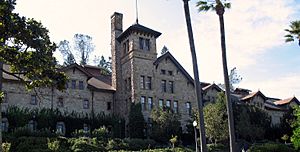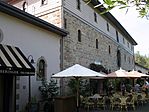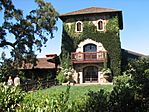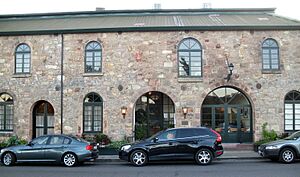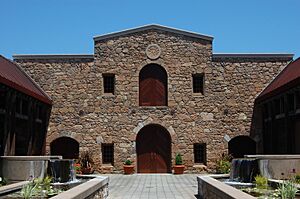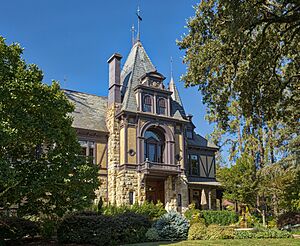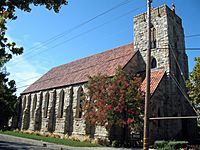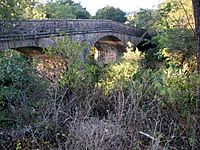St. Helena, California facts for kids
Quick facts for kids
St. Helena
|
|
|---|---|
|
Clockwise: The Culinary Institute of America at Greystone; V. Sattui Winery; the Richie Block downtown; former train depot; Beringer Vineyards
|
|
| Motto(s):
"Napa Valley's Main Street",
|
|
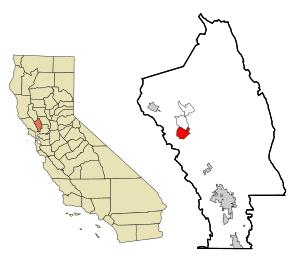
Location in Napa County and the state of California
|
|
| Country | United States |
| State | California |
| County | Napa |
| Incorporated | March 24, 1876 |
| Re-incorporated | May 14, 1889 |
| Government | |
| • Type | Council–manager |
| Area | |
| • City | 5.08 sq mi (13.16 km2) |
| • Land | 4.96 sq mi (12.83 km2) |
| • Water | 0.13 sq mi (0.33 km2) 0.81% |
| Elevation | 253 ft (77 m) |
| Population
(2020)
|
|
| • City | 5,438 |
| • Density | 1,231.5/sq mi (475.49/km2) |
| • Metro | 138,019 |
| Time zone | UTC-8 (Pacific) |
| • Summer (DST) | UTC-7 (PDT) |
| ZIP code |
94574
|
| Area code | 707 |
| FIPS code | 06-64140 |
| GNIS feature IDs | 277588, 2411758 |
St. Helena is a city in Napa County, California, United States. It is located in the North Bay part of the San Francisco Bay Area. In 2020, about 5,438 people lived there.
St. Helena is a popular place for tourists. People visit because of its many vineyards and great food. The city is the center of the St. Helena American Viticultural Area (AVA). This is a special area for growing grapes. It covers about 9,060 acres (about 14 square miles) of the Napa Valley. Over 400 vineyards are found here, with 6,800 acres of grapevines. St. Helena is also home to The Culinary Institute of America at Greystone and a campus of Napa Valley College.
Contents
History of St. Helena
St. Helena was first home to a Native American group called the Wappo people. They spoke a language called Yukian. It is believed they settled in St. Helena as early as 2000 B.C. The Wappo name for this area was Anakotanoma, which means "Bull Snake Village."
The city likely got its name from a nearby mountain, Mount St. Helena.
Early Days and the Resort
The area became well-known when White Sulphur Springs was found in 1848. It opened as a resort in 1852. In the late 1800s, rich people from San Francisco would travel here. They came by steamer across the San Francisco Bay, then by stagecoach, and later by train. This old resort could host 1,000 guests in its large hotels. Sadly, these hotels were later destroyed by wildfires. Today, the site is a National Historic Landmark.
How St. Helena Grew
The town of St. Helena was started by Henry Still. He bought land from the Edward Bale family in 1855. By 1858, there was already a school and a small Baptist church. Four years later, Professor William Brewer described it as a "pretty little village" with more than fifty houses. St. Helena officially became a town on March 24, 1876. By 1886, its population had grown to 1,800 people.
In 1868, the first railroad was built in St. Helena. This allowed resources like fruit and mining products to be shipped out. The new train tracks also made it easier for tourists to visit.
Important Landmarks and People
Ellen White, who helped start the Seventh-day Adventist Church, lived near St. Helena from 1900. Her home, called Elmshaven, is now a National Historic Landmark. Both the Beringer Vineyards and the Charles Krug Winery are also recognized as California Historical Landmarks.
St. Helena's community center was once a Carnegie library. It served as the city's library from 1908 to 1978.
Geography and Climate
St. Helena covers about 5.03 square miles (13.0 square kilometers) in total. Most of this area, about 4.99 square miles (12.9 square kilometers), is land. A small part, about 0.11 square miles (0.28 square kilometers), is water.
Weather in St. Helena
The weather in St. Helena is measured by a station there. Winters are cool and wet. Summers have hot days but cool nights, with very little rain.
In December, the coldest month, temperatures usually range from 39.6°F (4.2°C) to 58.3°F (14.6°C). In July and August, the warmest months, temperatures usually range from 56°F (13°C) to 89°F (32°C).
On average, there are about 55 days each year when the temperature reaches 90°F (32°C) or higher. There are also about 14 days when the temperature drops to 32°F (0°C) or lower. The hottest temperature ever recorded was 115°F (46°C) on July 13, 1972. The coldest was 11°F (-12°C) on December 11, 1932.
St. Helena gets about 34 inches (863 millimeters) of rain each year. It rains on about 68 days a year. Snow rarely falls, but there is a tiny average of 0.2 inches (5 millimeters) per year.
| Climate data for St. Helena, California, 1991–2020 normals, extremes 1907–present | |||||||||||||
|---|---|---|---|---|---|---|---|---|---|---|---|---|---|
| Month | Jan | Feb | Mar | Apr | May | Jun | Jul | Aug | Sep | Oct | Nov | Dec | Year |
| Record high °F (°C) | 83 (28) |
86 (30) |
95 (35) |
98 (37) |
107 (42) |
110 (43) |
115 (46) |
112 (44) |
113 (45) |
104 (40) |
93 (34) |
83 (28) |
115 (46) |
| Mean maximum °F (°C) | 70.9 (21.6) |
75.1 (23.9) |
80.8 (27.1) |
87.6 (30.9) |
93.0 (33.9) |
100.9 (38.3) |
102.4 (39.1) |
102.0 (38.9) |
100.4 (38.0) |
92.6 (33.7) |
79.6 (26.4) |
69.6 (20.9) |
105.0 (40.6) |
| Mean daily maximum °F (°C) | 58.8 (14.9) |
62.5 (16.9) |
66.8 (19.3) |
71.8 (22.1) |
78.1 (25.6) |
85.4 (29.7) |
88.7 (31.5) |
88.8 (31.6) |
86.6 (30.3) |
78.1 (25.6) |
65.8 (18.8) |
58.3 (14.6) |
74.1 (23.4) |
| Daily mean °F (°C) | 49.5 (9.7) |
52.2 (11.2) |
55.4 (13.0) |
59.0 (15.0) |
64.3 (17.9) |
69.8 (21.0) |
72.4 (22.4) |
72.3 (22.4) |
70.2 (21.2) |
63.7 (17.6) |
54.7 (12.6) |
48.9 (9.4) |
61.0 (16.1) |
| Mean daily minimum °F (°C) | 40.2 (4.6) |
41.9 (5.5) |
43.9 (6.6) |
46.3 (7.9) |
50.5 (10.3) |
54.2 (12.3) |
56.0 (13.3) |
55.7 (13.2) |
53.8 (12.1) |
49.4 (9.7) |
43.7 (6.5) |
39.6 (4.2) |
47.9 (8.8) |
| Mean minimum °F (°C) | 29.9 (−1.2) |
32.0 (0.0) |
34.8 (1.6) |
37.1 (2.8) |
42.0 (5.6) |
46.3 (7.9) |
49.9 (9.9) |
50.1 (10.1) |
45.8 (7.7) |
39.8 (4.3) |
32.2 (0.1) |
28.2 (−2.1) |
26.3 (−3.2) |
| Record low °F (°C) | 16 (−9) |
18 (−8) |
24 (−4) |
27 (−3) |
31 (−1) |
36 (2) |
37 (3) |
38 (3) |
33 (1) |
22 (−6) |
11 (−12) |
13 (−11) |
11 (−12) |
| Average precipitation inches (mm) | 6.47 (164) |
6.71 (170) |
4.98 (126) |
1.97 (50) |
1.31 (33) |
0.35 (8.9) |
0.01 (0.25) |
0.04 (1.0) |
0.06 (1.5) |
1.65 (42) |
3.24 (82) |
7.18 (182) |
33.97 (863) |
| Average precipitation days (≥ 0.01 in) | 13.3 | 10.6 | 10.4 | 5.5 | 3.4 | 0.8 | 0.2 | 0.1 | 0.5 | 3.3 | 8.1 | 12.9 | 69.1 |
| Source 1: NOAA | |||||||||||||
| Source 2: National Weather Service | |||||||||||||
People of St. Helena
| Historical population | |||
|---|---|---|---|
| Census | Pop. | %± | |
| 1880 | 1,339 | — | |
| 1890 | 1,705 | 27.3% | |
| 1900 | 1,582 | −7.2% | |
| 1910 | 1,603 | 1.3% | |
| 1920 | 1,346 | −16.0% | |
| 1930 | 1,582 | 17.5% | |
| 1940 | 1,758 | 11.1% | |
| 1950 | 2,297 | 30.7% | |
| 1960 | 2,722 | 18.5% | |
| 1970 | 3,173 | 16.6% | |
| 1980 | 4,898 | 54.4% | |
| 1990 | 4,990 | 1.9% | |
| 2000 | 5,950 | 19.2% | |
| 2010 | 5,814 | −2.3% | |
| 2020 | 5,438 | −6.5% | |
| U.S. Decennial Census | |||
In 2010, St. Helena had a population of 5,814 people. Most people, about 77.8%, were White. About 16.8% were from other races, and 2.5% were from two or more races. About 32.9% of the people were Hispanic or Latino.
Most of the population (98.3%) lived in homes. There were 2,401 households. About 28.9% of these households had children under 18. The average household had 2.38 people.
About 22.0% of the people were under 18 years old. About 19.3% were 65 years or older. The average age in St. Helena was 42.9 years.
Economy of St. Helena
Major companies that employ people in St. Helena include Trinchero Family Estates, Beringer Vineyards, and The Culinary Institute of America.
The city has a special rule against chain restaurants. Only one, an A&W, is allowed because it was there before the rule started. The St. Helena AVA is a special area for growing grapes around the town, created in 1995. Many vineyards and wineries are located near St. Helena, such as Duckhorn Vineyards, Newton Vineyard, Charles Krug Winery, and Brown Estate. Adventist Health St. Helena hospital is in the nearby town of Deer Park.
Education in St. Helena
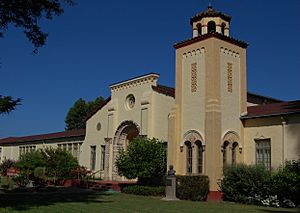
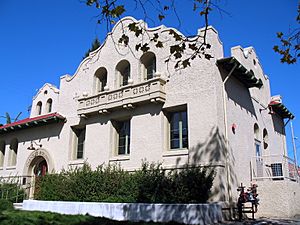
The local school district is the Saint Helena Unified School District.
- Saint Helena Primary School teaches kindergarten through second grade.
- Saint Helena Elementary School teaches grades three through five. It is ranked as the second-best public school in the Napa Valley.
- Robert Louis Stevenson Middle School teaches grades six through eight. It is ranked as the best public middle school in the Napa Valley. It has a great teacher-to-student ratio of 13:1.
- St. Helena High School teaches grades nine through twelve. It is ranked as the best public high school in the Napa Valley.
The city also has two college campuses:
- The Upper Valley Campus of Napa Valley College.
- The Culinary Institute of America at Greystone, which is a branch of the main cooking school in Hyde Park, New York.
Notable People from St. Helena
Many interesting people have connections to St. Helena:
- Michela Alioto-Pier, a former member of the San Francisco Board of Supervisors.
- David Duncan, a winemaker.
- Louise E. Francis, a journalist.
- William Hamilton, a cartoonist and playwright.
- Siegfried Horn, an archaeologist and Bible expert.
- William B. Hurlbut, a professor at Stanford University Medical Center.
- Charles Krug, a famous winemaker.
- Bob Marshall, a mayor of San Bruno, California.
- Fritz Maytag, a businessman.
- Donald C. McRuer, a congressman.
- Peter Newton, a winemaker.
- Charles O'Rear, a photographer.
- Carl Osburn, a naval officer and sports shooter.
- Frank K. Richardson, a judge on the California Supreme Court.
- Dave Smith, an engineer and musician.
- Edwin R. Thiele, a missionary, writer, and archaeologist.
- Mike Thompson, a U.S. Representative who grew up in St. Helena and still lives there.
- Josephine Tychson, the first woman to build and run a winery in California.
- Owen Wade, a politician.
- Ellen G. White, an author and co-founder of the Seventh-day Adventist Church.
See also
 In Spanish: St. Helena (California) para niños
In Spanish: St. Helena (California) para niños


